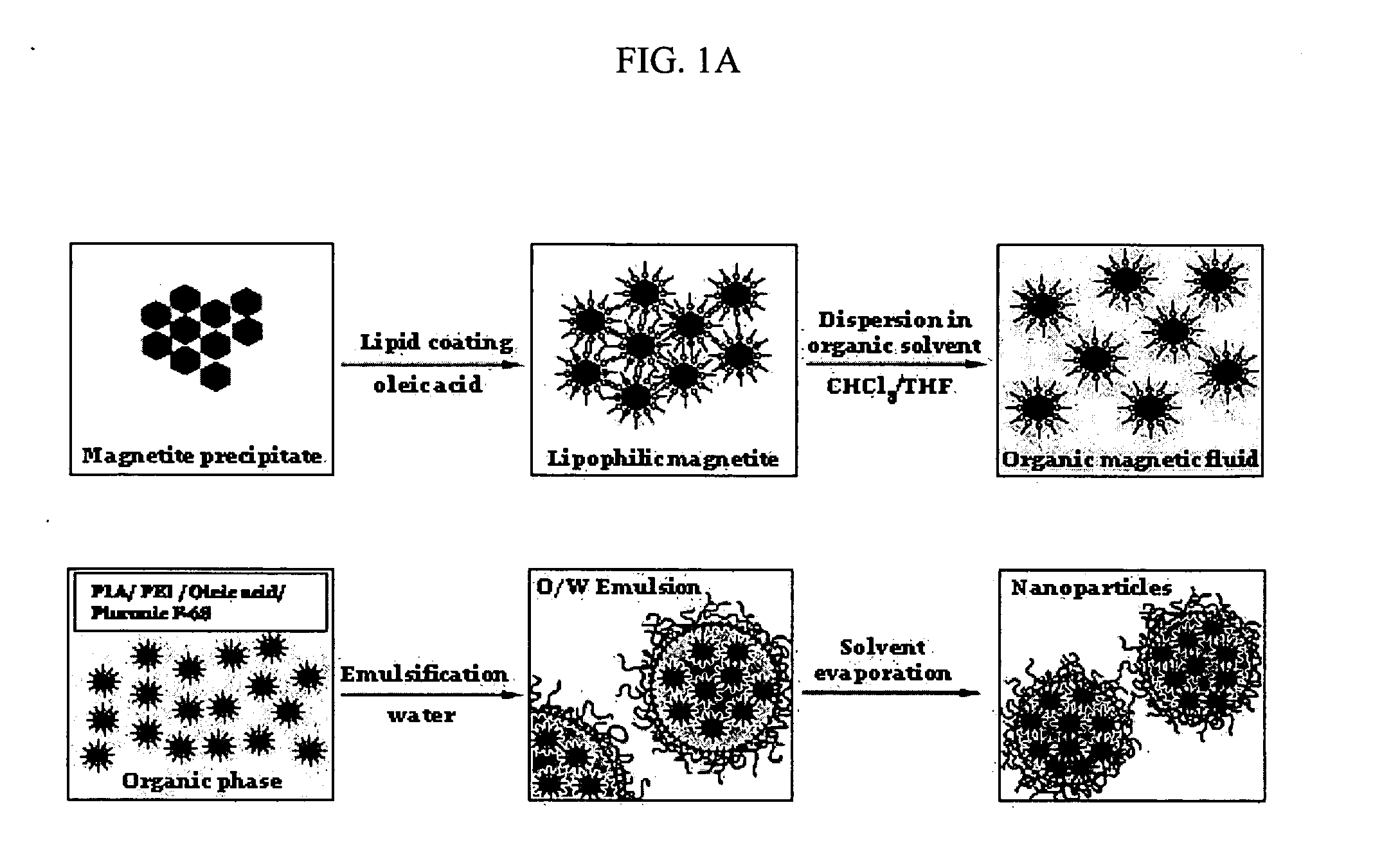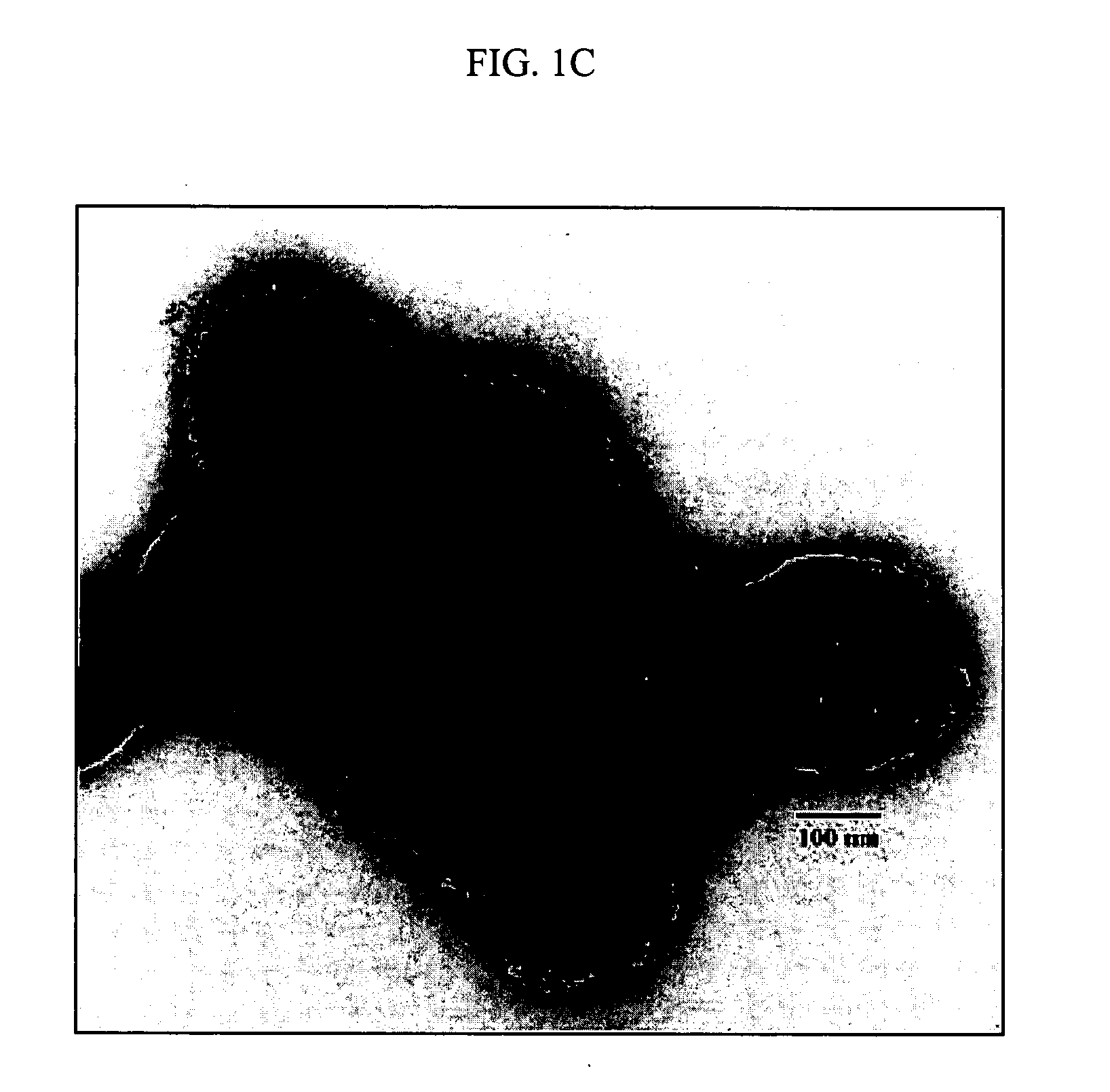Magnetically-driven biodegradable gene delivery nanoparticles formulated with surface-attached polycationic complex
a nanoparticle and surface-attached polymer technology, applied in the field of biomaterial delivery, can solve the problems of slow accumulation, relatively little progress in dna incorporation into biodegradable sustained release particles, and ineffective vehicles of nanoparticles for gene delivery
- Summary
- Abstract
- Description
- Claims
- Application Information
AI Technical Summary
Benefits of technology
Problems solved by technology
Method used
Image
Examples
example 1
Preparation of a Coated Magnetic-Field Responsive Agent
[0171] The formulation of superparamagnetic biodegradable nanoparticles involves at least two steps: forming a long-chain carboxylic acid stabilized iron oxide nanocrystals and incorporation of the iron oxide nanocrystals in the biodegradable polymeric matrix of PLA-based nanoparticles formulated with PEI. The first step involves co-precipitation of ferric and ferrous chlorides in the presence of aqueous base solution (NaOH, O. IN) with subsequent coating with oleic acid, thus rendering the nanocrystal surface lipophilic (see De Cuyper, supra; and Khalafalla supra). The obtained stabilized iron oxide nanocrystals were separated by extraction or centrifugation / magnetic sedimentation with subsequent resuspension in chloroform or a mixture of chloroform and tetrahydrofuran.
[0172] 1 ml of an aqueous solution containing 65 mg of FeCl3 hexahydrate, 32 mg of FeCl2 tetrahydrate and 50 mg of Pluronic F-68 (as an optional stabilizer) (B...
example 2
Use of Solvent to Control Size of Particle
[0177] Use of tetrahydrofuran (THF), a water-miscible solvent, in a mixture with chloroform to form the organic phase allows to considerably decrease the size of the resultant nanoparticles, thus making possible to optimize the nanoparticle uptake by a given cell type without affecting the amounts of the structural components in the formulation (i.e. PLA, PEI, Fe3O4, oleic acid) and the colloidal stability of the dispersion. Therefore, one can independently control size and surface charge, which is unachievable in complexes prepared by simply combining DNA and PEI. The effect of varying the volume of THF and chloroform (the organic phase composition) on particle magnetic behavior and size is shown in FIGS. 2A and 2B. The total volume of the tetrahydrofuran / chloroform mixture was kept constant and equal to 6.0 ml.
[0178] All magnetic formulations: 0 ml THF (large NP, LNP), 3 ml THF (medium NP, MNP), and 4.5 ml THF (small NP, SNP)) exhibit su...
example 3
Gene Transfer Efficiency and Cell Toxicity
[0179] Next, particles were studied for transfection of cells in culture. Three kinds of magnetically responsive particles were prepared and complexed with DNA at different PEI:DNA ratios In all experiments, nanoparticles were complexed with 0.25 μg GFP-encoding DNA plasmid per well in 5% glucose for 30 min, then mixed 1:4 with cell culture medium supplemented with 10% serum and applied to cells for 10 min with magnetic field. Their transfection efficiency, as well as nanoparticles uptake and toxicity was studied in cultured rat aortic smooth muscle and bovine aortic endothelial cells (A10 and BAEC, respectively) using non-magnetic particles as a control. Gene expression, NP uptake and cell survival were determined by measuring fluorescence at 485 / 535 nm, 620 / 670 nm and with the Alamar Blue assay, respectively, at 2 day time point. The results are presented in FIGS. 4A-4F. Magnetically responsive formulations resulted in high levels of gene...
PUM
| Property | Measurement | Unit |
|---|---|---|
| diameter | aaaaa | aaaaa |
| diameter | aaaaa | aaaaa |
| particle's diameter | aaaaa | aaaaa |
Abstract
Description
Claims
Application Information
 Login to View More
Login to View More - R&D
- Intellectual Property
- Life Sciences
- Materials
- Tech Scout
- Unparalleled Data Quality
- Higher Quality Content
- 60% Fewer Hallucinations
Browse by: Latest US Patents, China's latest patents, Technical Efficacy Thesaurus, Application Domain, Technology Topic, Popular Technical Reports.
© 2025 PatSnap. All rights reserved.Legal|Privacy policy|Modern Slavery Act Transparency Statement|Sitemap|About US| Contact US: help@patsnap.com



